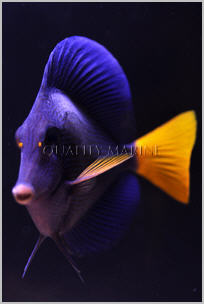The Purple Tang - Revisted

Natural Habitat
Purple tangs are most commonly collected in the Red Sea and occasionally found in the Arabian Sea, the Gulf of Aden, and in the waters near Sri Lanka. They are shallow-mid water fish, rarely seen at depths over 20 meters. The Red Sea is regarded as one of the most saline bodies of water in the world, resulting from evaporation due to high temperatures, strong winds, and the fact that no rivers feed into it. With the harsh tropical sun and dry desert conditions where annual rainfall averages less than an inch, the Red Sea loses the equivalent of about six feet of water each year through evaporation. The salinity ranges between 36 and 38% which equates to a specific gravity of approximately 1.026 to 1.028. The northern Red Sea is generally more saline than the southern end as it is further from the only inlet to the sea. Additionally, in the north Red Sea water temperatures average 78 F while in the southern region temperatures average 86 F.
The Purple Tang is usually found living singly, but can also occasionally be found in schools especially in the southern Red Sea. They typically inhabit coral-rich areas or rocky bottoms where they constantly feed on the various types of algae which thrive in the sun-drenched shallower waters of the reef. Studies also show that the Purple tang spends up to 55 to 70% of their time grazing (Montgomery, et al.). As such they have developed abnormally long digestive tracts in order digest the large quantity of plant matter they consume.

Aquarium Suitability
In the aquarium, much like any fish, it is best to provide the purple tang an environment similar to what it is used to in the wild. This should include a large amount of water movement, high dissolved oxygen content, and plenty of space to swim and hide. Being such active grazers and swimmers, we recommend they are placed in aquariums no smaller than 75 gallons, however the bigger the aquarium the better. The purple tang is ideal for tanks with ample amounts of algae, which serves as a consistent food source and something for the very active tang to keep busy with. The tang returns the favor by keeping the unsightly algae growth in check. For aquariums with little algae growth, we recommend feeding live macro algae as a part of their diet. In lieu of this, dried algae or nori should be fed.
Purple tangs are well known for being susceptible to diseases caused from malnourishment, such as HLLE (Head and Lateral Line Erosion), a disease where parts of the head and areas around the lateral line slowly begin to erode away. To prevent or remedy this situation it is important to make sure their food is high in HUFA's (Highly Unsaturated Fatty Acids) and the blue-green alga spirulina. Periodically soaking prepared foods in vitamin enriched selcon or other types of liquid vitamins can be used to supplement foods that may be vitamin deficient and will help to prevent malnourishment.
The Purple tang is also notorious for being one of the most aggressive members of the Acanthuridae family. They will rarely get along with other Acanthurid and are especially aggressive towards members of their Genus, such as the Scopas, Yellow, Sailfin, and Black Tangs. Purple tangs can also be belligerent towards other peaceful fish, and as such, we recommend that they not be added to very peaceful tanks. Additionally, if several purple tangs or other Acanthurid are desired, it is helpful to introduce them into the aquarium all at the same time.
All in all the Purple Tang can be a great, hardy, and beautiful addition to the reef aquarium. With proper tank maintenance, design, and feeding habits the aquarist can have tremendous success with these beauties of the Red Sea. Given the right conditions they can be a remarkably hardy tang and will thrive in their captive environments.
Bibliography:
Montgomery, WL; Myrberg, AA Jr; Fishelson, L. (1989) Feeding ecology of surgeonfishes (Acanthuridae) in the northern Red Sea, with particular reference to Acanthurus nigrofuscus (Forsskaal). Journal of Experimental Marine Biology and Ecology. Vol. 132, no. 3, pp. 179-207.